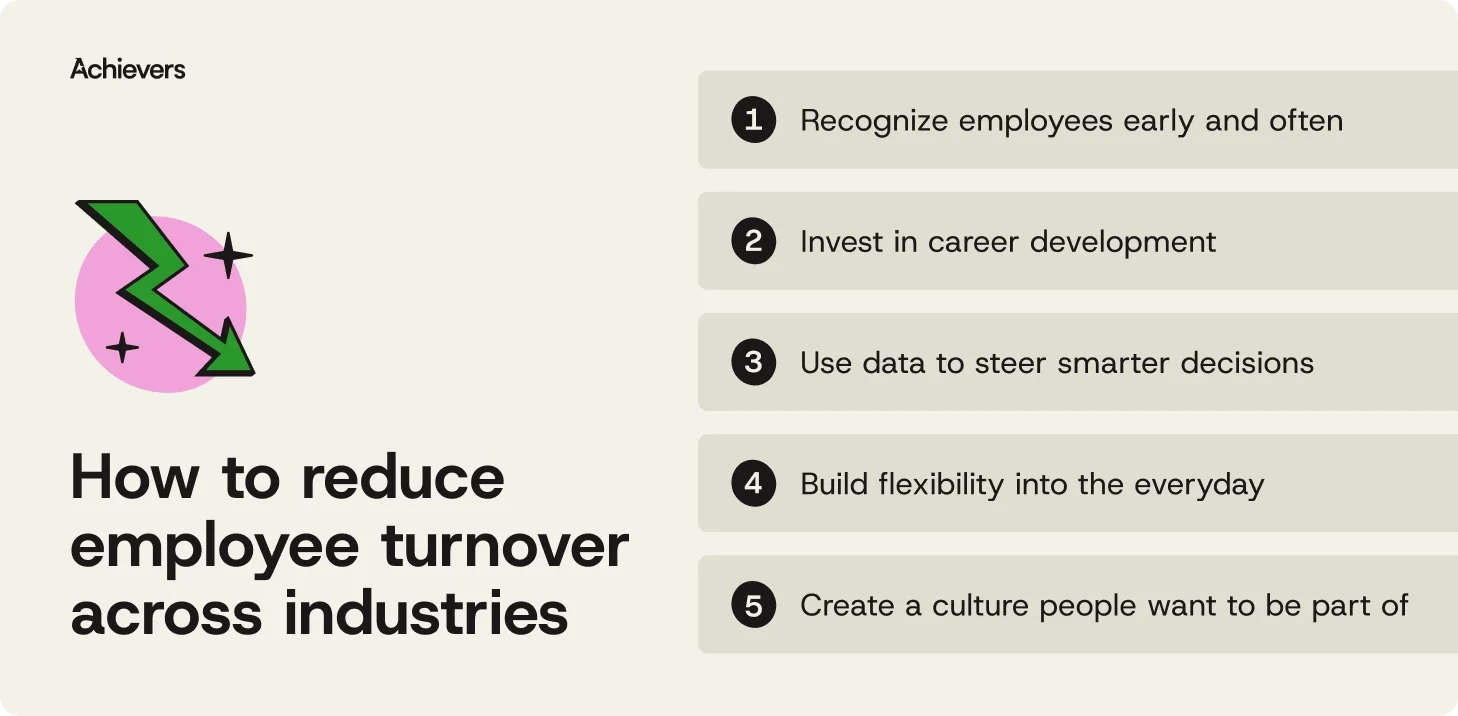Table of contents
Create a culture that means business™
Schedule a demo with an Achievers solution expert today.
Remember when half your workforce was one bad meeting away from quitting? Good news: those days are (mostly) behind us. After peaking at 53% in 2022, the percentage of employees eyeing the exit has dropped to 28%, with another 11% still open to the right offer.
Some are calling it “The Great Stay.” But let’s not break out the confetti just yet.
Employee turnover still packs a punch — financially and culturally. Replacing a single team member can cost anywhere from half to four times their salary. And that’s before you count the hit to innovation, momentum, and morale.
The truth? Retention is still your best defense. In this blog, we’ll unpack industry trends, tackle common retention blockers, and explore how you can strengthen loyalty with strategies that make employees feel seen, heard, and — most importantly — motivated to stay.
Let’s dig in.
Employee turnover by industry: An analysis
Some roles are harder to fill than others — and when those roles sit in industries like healthcare, finance, manufacturing, or professional services, turnover costs can spike fast. These fields rely on highly skilled talent, which makes every departure feel like a gut punch. The fix? A stronger focus on employee recognition, well-being, and culture. Because retaining top talent is a lot cheaper than replacing it.
Here’s where turnover hits hardest — and why it matters:
Healthcare
After a grueling half-decade, healthcare workers are still running on empty — and many are running for the exits. In 2024, registered nurse turnover hit 18.4%, and physician turnover reached 13%. Hospitals saw annual average turnover rates of 20.7%, with even higher numbers in nursing homes and home care settings.
The culprits? Burnout and staffing shortages, often working hand in hand. Nearly half of U.S. healthcare workers report burnout — that’s fatigue, emotional exhaustion, and a creeping sense of “I can’t do this anymore.” And with the World Health Organization (WHO) forecasting an 11-million worker shortfall by 2030, the strain isn’t easing up.
When roles remain unfilled, the pressure lands on those who stay. It’s a cycle that erodes morale, psychological safety, and retention. Investing in a culture that values recognition and well-being isn’t just good for people — it’s critical for the sustainability of the entire sector.
Financial services
In the world of finance, turnover is trending up — despite the high paychecks. Non-officer roles now see about 20% turnover, while officer-level roles have nearly doubled since 2021, rising to 6.5%.
Financial services has long been a high-stress, high-reward field, but salary alone no longer seals the deal. Today’s employees are looking for more: flexibility, purpose, and recognition. They want remote options. They want to feel valued. And they want employers who understand that performance isn’t just about spreadsheets — it’s about people.
Tracking key retention metrics — like voluntary turnover, new hire exits, and employee satisfaction — can help financial organizations move beyond guesswork and start building workplaces worth staying in.
Manufacturing
In manufacturing, turnover doesn’t just hurt morale — it hits the bottom line. According to Deloitte, replacing a single skilled frontline worker can cost anywhere from $10,000 to $40,000. With an average monthly quit rate of 1.6%, that adds up fast.
Two major hurdles stand in the way: wage competition and safety. Many manufacturers are increasing pay to stay competitive — but that alone won’t move the needle. Nearly one-third of manufacturing employees say workplace safety is the area where they feel most ignored.
The message is clear: when employees speak up about safety concerns, listen. Recognize their feedback. Act on it. Manufacturers that prioritize safety, communication, and consistent recognition will earn something that’s becoming increasingly rare — loyalty.
Professional services
Consulting, legal, and IT roles have long been the career track of choice for high performers — and the career track out for high turnover. In 2024, many companies in the professional services space saw attrition outpace hiring, with growing concern about the shrinking pool of skilled talent.
So, what’s driving the exits? Three key areas: career growth, job satisfaction, and workload.
Professional services employees expect more than a paycheck — they want meaningful work, manageable hours, and a clear path forward. But when promotions stall or the work becomes a grind, top talent will take their skills elsewhere.
A survey of more than 7,700 tech professionals found that one-third had switched jobs in the past two years. The top reasons? Compensation, career development, and more engaging work. And 54% called out heavy workloads as a top stressor.
Retention in professional services starts with recognition, support, and real conversations about what success looks like — for the business and the people behind it.
6 smart strategies to reduce employee turnover by industry
If you’re feeling the sting of turnover, you’re not alone — especially in high-impact industries like healthcare, finance, manufacturing, and professional services. The good news? With the right strategy, you can turn the tide. Here are a few proven ways to boost retention, build engagement, and create a workplace where top talent wants to stay:

1. Recognize employees early, often — and meaningfully
A little appreciation goes a long way — especially in high-stress roles. Recognition isn’t just a morale booster; it’s a proven retention tool.
- Healthcare: Timely recognition can be a powerful antidote to burnout. Catch people doing something great — especially when they’re overwhelmed — and make sure they know it matters.
- Financial services: Celebrate high-stakes wins. Whether it’s hitting a sales milestone or closing a deal, recognition makes the pressure feel worthwhile.
- Manufacturing: Acknowledge safety compliance and hitting production targets. It’s practical, appreciated — and easy to overlook.
- Professional services: Reward big client wins and clever problem-solving. Innovation deserves more than a polite nod.
2. Invest in career development
If you want people to stay, give them a reason to grow. Career development isn’t just a perk — it’s a promise.
- Healthcare: Open up leadership pathways for nurses, support specialization, and empower administrative staff to rise.
- Financial services: Support certifications like CPA or CFA. Internal growth keeps top talent close — and loyal.
- Manufacturing: Upskill or reskill frontline workers into supervisory roles. Advancement shouldn’t require leaving the building.
- Professional services: Sponsor training, certifications, and mentorship. When 94% of employees say they’d stay if you invested in their careers, maybe it’s worth doing.
3. Use data to steer smarter decisions
You can’t fix what you can’t see. Real-time feedback and people analytics are your best bet for catching problems early — and acting before it’s too late.
- Healthcare: Track burnout signals through pulse surveys and feedback tools. Act fast when teams show signs of fatigue.
- Financial services: Identify your rising stars with platform data. Recognize performance before recruiters come knocking.
- Manufacturing: Surface safety or morale issues through consistent feedback loops. Then act — visibly.
- Professional services: Use sentiment analysis to monitor engagement and belonging. Predict attrition before it happens.
4. Build flexibility into the everyday
Work-life balance shouldn’t be a buzzword. It should be baked into how — and when — work gets done.
- Healthcare: Flexible scheduling helps staff feel human again. When possible, let them reclaim control over their time.
- Financial services: Hybrid work is here to stay. In fact, 85% of financial employees prefer working remotely 2–3 days a week.
- Manufacturing: Try four-day weeks or rotating shifts. A little scheduling creativity can improve morale without slowing production.
- Professional services: Encourage unplugged time and generous time-off policies. Rested brains make better business decisions.
5. Create a culture people want to be part of
This one’s big. Company culture isn’t built overnight, but it is built — through trust, communication, and reinforcement of shared values.
- Healthcare: Foster collaborative, supportive teams. It’s a direct counter to burnout and a boost to well-being.
- Financial services: Champion transparency, ethics, and shared wins. A values-led culture keeps people proud — and present.
- Manufacturing: Involve employees in decisions and prioritize safety. When people feel heard, they tend to stick around.
- Professional services: Create strong mentorship networks and open lines of communication. Culture thrives where people feel connected.
6. Prioritize employee well-being as a business imperative
Retention starts with resilience. When employees feel supported — physically, mentally, and emotionally — they’re far more likely to stay and thrive.
- Healthcare: Offer mental health resources and stress management programs to combat burnout.
- Financial services: Provide access to wellness stipends and confidential counseling to ease high-pressure environments.
- Manufacturing: Invest in ergonomic workspaces and proactive safety measures to protect both body and mind.
- Professional services: Encourage regular check-ins and promote mental health days to keep pace with demanding client work.
The upside of getting turnover under control
Reducing employee turnover isn’t just about plugging a leak — it’s about building a workplace where people want to stay. And yes, the ROI is real.
When someone walks out the door, the price tag can be steep — up to four times their annual salary, once you add in recruiting, onboarding, training, and all the lost productivity in between. But turnover doesn’t just drain your budget. It chips away at morale, disrupts team dynamics, and sends valuable institutional knowledge out the door.
On the flip side? A stable, motivated workforce means more continuity, deeper expertise, and better service — which your customers will definitely notice (and appreciate).
Just ask Vistex. With over 1,500 employees across 17 locations, they knew employee engagement was critical. An internal survey revealed one simple but powerful insight: employees wanted a better way to recognize each other. After rolling out Achievers, turnover dropped by 22%. Sometimes the smartest solution starts with a simple “thank you.”
Recognition doesn’t just feel good. It works.
Cut costs and boost performance by keeping your best people
Turnover may have eased since the Great Resignation, but for industries like healthcare, finance, manufacturing, and professional services, the costs still pack a punch. And let’s be honest — no organization is completely immune. When top talent walks, it leaves a dent in productivity, culture, and your bottom line.
The solution? Smarter investment.
Organizations that lead in retention don’t just cross their fingers and hope for loyalty — they build it. That means prioritizing employee engagement, frequent recognition, clear career paths, flexible work options, and a culture people want to be part of. And when those efforts are grounded in real-time data? Even better.
Achievers helps you take the guesswork out of engagement. Our platform delivers actionable insights, high-frequency recognition, and continuous feedback — everything you need to shape a workforce that’s motivated to stay and empowered to perform.
Because keeping great people isn’t just good business — it’s how the best businesses grow.
Employee turnover by industry FAQs
Key insights
- Industries like hospitality and food service experience the highest turnover rates, often exceeding 70%, due to low wages and demanding work conditions.
- Professional services and healthcare also face significant turnover challenges, driven by burnout and competitive talent markets.
- Sectors such as financial services, tech, and manufacturing maintain relatively low turnover rates, reflecting stronger retention strategies and higher job stability.



